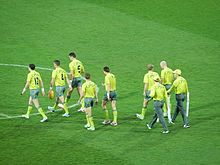Brownlow Medal
Excluding the change of the monogram from VFL to AFL in 1990, the design, shape and size of the medallion have been virtually unchanged since 1924.
[9] The fairest component of the medal is achieved by making ineligible any player who is suspended by the AFL Tribunal during the home-and-away season.
Some of the game's greatest players in these positions never even came close to winning the Brownlow despite having high reputations amongst their peers and coaches.
[13] Several prominent coaches, including Kevin Sheedy and Leigh Matthews, have publicly criticised the voting process.
The temporary break from tradition under the demerit points-based tribunal system (which saw player being ineligible despite not having served suspensions) was also criticised as confusing.
Prominent players, including dual-winner Chris Judd, have indicated a desire to have the eligibility criterion removed from the award (effectively eliminating the fairest component altogether);[14] but this view is not universally held, and 1958 winner Neil Roberts stated in 1988 that he would hand back his medal if the fairness criterion were removed.
[16] This aspect of the night has become widely reported by gossip columns, with the red carpet arrival often humorously referred to as the 'Gownlow'.
[17] The ceremony is currently held at Crown Melbourne on the Monday five days prior to the AFL Grand Final.
[20] In years past, prospective Grand Final players have attended the ceremony in person, but in recent years non-Victorian Grand Final teams have declined to attend the ceremony due to the inconvenience of travel in such an important week; a live video link to Brownlow functions in their home city is done instead.
At the end of the final season in 1943, Corporal Peter Chitty won a makeshift award known as the "Changi Brownlow", which his family later donated to the Australian War Memorial.
It is variously claimed the medal was originally a piece of an aircraft wing or part of a kitchen utensil.



